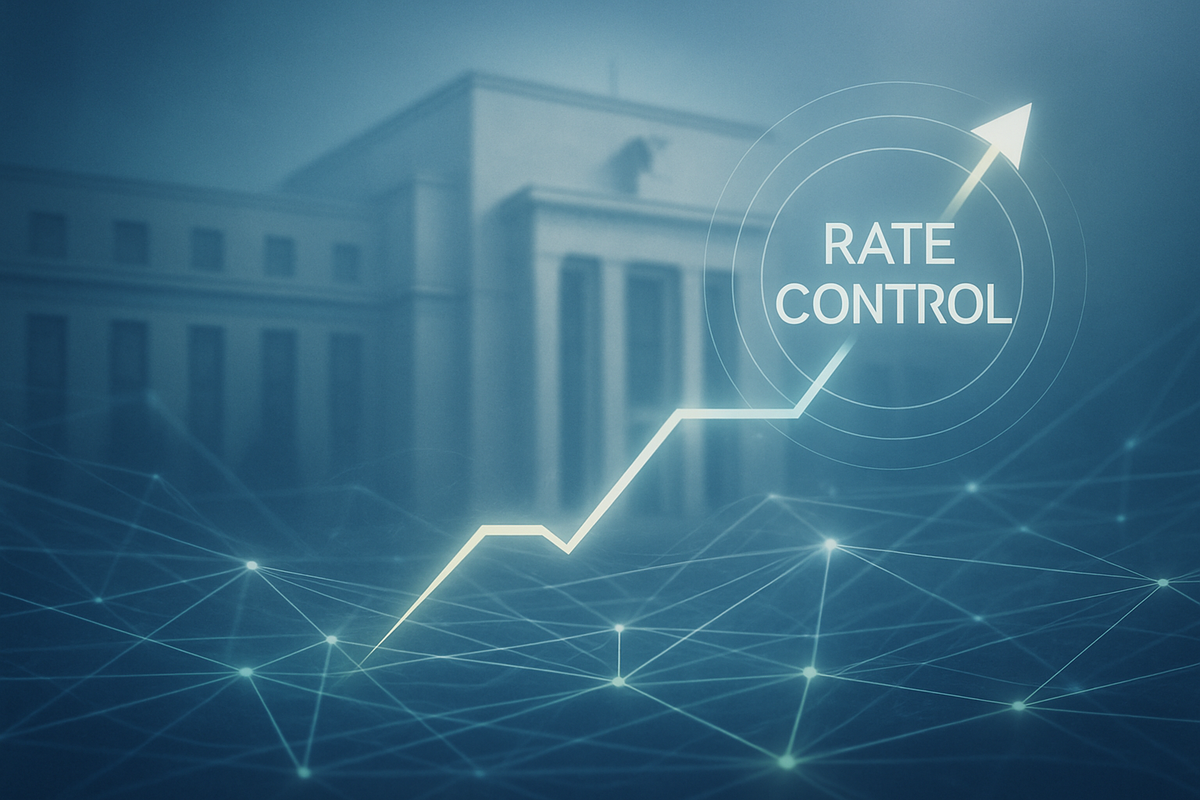Dallas Fed's Logan Calls for Major Overhaul of Fed's Rate Control Toolkit: A Proactive Move for Financial Stability
By:
MarketMinute
September 25, 2025 at 16:12 PM EDT

Dallas Federal Reserve President Lorie Logan has issued a compelling call for a significant overhaul of the central bank's rate control toolkit, advocating for a shift away from the traditional federal funds rate as the primary policy target. This proposal, articulated amidst a period of relative market calm, is not a signal of an immediate change in monetary policy but rather a proactive measure aimed at modernizing the Federal Reserve's operational framework to ensure greater stability and resilience in monetary policy implementation for the long term. Logan's initiative underscores a growing recognition within the Fed that the existing framework, largely established in the mid-1990s, is becoming increasingly outdated and potentially fragile in the face of evolving financial markets. Her suggested reforms are designed to fortify the central bank's ability to reliably steer interest rates, particularly during future periods of market stress, thereby enhancing both market liquidity and overall financial stability. A Technical Pivot: Strengthening the Fed's Operational FoundationPresident Logan's proposal centers on a critical technical adjustment: transitioning the Federal Open Market Committee's (FOMC) primary interest rate target from the federal funds rate to the Tri-Party General Collateral Rate (TGCR). This recommendation stems from deep-seated concerns regarding the inherent fragility of the current federal funds market. Logan points out that the stability of this market is heavily reliant on a concentrated group of lenders, notably 11 Federal Home Loan Banks (FHLBs), and a relatively small number of bank borrowers. This concentration creates a vulnerability, as starkly demonstrated during the spring 2023 banking turmoil when FHLBs significantly curtailed their lending, posing a palpable risk to overall market stability. Logan's objective is clear: to "take that risk off the table" by addressing these brittle interconnections. The shift to the TGCR is championed for its robustness and broad market representation. The TGCR, which reflects over $1 trillion in daily risk-free transactions, offers a "cleaner target" by encompassing the marginal cost of funds and return on investment for a much wider array of market participants. Its calculation methodology is deemed reliable, and its effectiveness in transmitting across money markets is well-established. Given the repo market's central role in today's money markets, Logan argues that the TGCR represents a logical and superior focus for the Fed's targeting efforts. Similar to the current federal funds rate, the FOMC would establish a 25-basis point range for the TGCR. This move is not entirely new territory for Logan. In earlier remarks, she also highlighted the importance of encouraging more banks to utilize the discount window and centrally clearing Standing Repo Facility (SRF) operations. These additional measures are designed to act as crucial backstops, preventing money-market interest rates from spiking unexpectedly during periods of market stress, thereby complementing the proposed shift to the TGCR. The timing of such an overhaul is also strategic; Logan emphasizes that implementation is best undertaken during periods of market calm, allowing for ample advance notice and smooth adaptation by market participants, rather than in the midst of a crisis. This forward-looking, technical recalibration aims to ensure the Fed's tools remain effective and adaptable to the dynamic financial landscape. Potential Winners and Losers in a Realigned Money MarketThe proposed shift in the Federal Reserve's primary interest rate target from the federal funds rate to the Tri-Party General Collateral Rate (TGCR) could subtly yet significantly alter the landscape for various financial market participants. While not a dramatic overnight change, the long-term implications could create winners and losers, primarily among institutions heavily involved in money markets and those whose funding models are sensitive to benchmark rates. Potential Winners:
Potential Losers (or those needing significant adaptation):
Ultimately, the long-term impact will depend on how seamlessly the transition occurs and how effectively market participants adapt to the new operational framework. The goal is to enhance overall market stability, which, in theory, should benefit all participants by reducing systemic risk. However, the immediate challenge will be for those institutions whose business models are most closely tied to the existing federal funds rate mechanism. Wider Significance: Adapting to a New Financial ParadigmPresident Logan's proposal to shift the Fed's primary interest rate target from the federal funds rate to the Tri-Party General Collateral Rate (TGCR) is more than just a technical tweak; it represents a significant acknowledgment of, and adaptation to, the evolving landscape of modern financial markets. This move fits squarely into broader industry trends characterized by the increasing dominance of secured markets and a financial system operating with ample reserves. For decades, the federal funds rate served as the bedrock of the Fed's monetary policy implementation. However, the post-2008 era, marked by quantitative easing and a surge in bank reserves, fundamentally altered money market dynamics. The federal funds market, once a vibrant arena for interbank lending, has become less representative of the broader cost of short-term funding. Secured markets, particularly the repurchase agreement (repo) market, have grown exponentially, becoming the central hub for liquidity management for a wide array of financial institutions. Logan's proposal acknowledges this reality, aiming to align the Fed's operational target with where the true gravitational center of money markets now lies. This shift could solidify the repo market's role as the primary conduit for monetary policy transmission, reflecting a natural evolution rather than a forced change. The regulatory implications of such a shift are primarily focused on enhancing financial stability. By targeting a more robust and broadly representative rate like the TGCR, the Fed aims to reduce the risk of market dislocations, especially during periods of stress. This proactive measure aligns with broader regulatory efforts since the 2008 financial crisis to de-risk the financial system and improve its resilience. While not a direct regulatory change, it provides a more stable foundation upon which existing and future regulations can operate. It also implicitly reinforces the importance of centrally cleared repo transactions and the discount window as essential backstops, pushing market participants towards more resilient funding practices. Historically, the Federal Reserve has a precedent for adapting its operational framework. The shift from targeting non-borrowed reserves to the federal funds rate in the mid-1990s was a similar move to align policy implementation with the prevailing market structure. Each adaptation reflected a commitment to ensuring the effectiveness of monetary policy in changing financial environments. This current proposal can be viewed as the latest iteration of this historical pattern, demonstrating the Fed's ongoing effort to maintain its grip on short-term interest rates in an increasingly complex and interconnected global financial system. By moving towards a more resilient and representative benchmark, the Fed aims to enhance its capacity to manage liquidity and maintain financial stability, thereby bolstering confidence in its ability to navigate future economic cycles and market challenges. What Comes Next: A Phased Transition to a More Robust FrameworkThe path forward following Dallas Fed President Lorie Logan's proposal for an overhaul of the central bank's rate control toolkit will likely involve a phased and deliberate transition, emphasizing careful planning and communication to ensure market stability. In the short term, the focus will be on internal discussions within the Federal Open Market Committee (FOMC) and engagement with key market participants. This period will involve detailed analysis of the TGCR's suitability, the operational mechanics of such a shift, and the necessary preparatory steps for market infrastructure. Investors should watch for further speeches or papers from Fed officials elaborating on the proposal, as well as any indications of a timeline for potential implementation. In the long term, should the FOMC adopt Logan's recommendation, the financial markets will witness a strategic pivot in how the central bank implements monetary policy. This shift would likely involve a multi-year horizon, allowing banks and other financial institutions ample time to adapt their funding strategies, risk management systems, and internal models. The move to a TGCR target would likely cement the importance of the secured repo market as the primary conduit for liquidity and interest rate transmission. This could lead to increased standardization and perhaps even greater central clearing within the repo market, further enhancing its resilience. Market opportunities may emerge in the development of new financial products or derivatives tied to the TGCR, offering new hedging and investment avenues. Conversely, challenges could arise for institutions less integrated into the tri-party repo market, requiring them to invest in new capabilities or partnerships. Potential scenarios and outcomes range from a smooth, well-managed transition that enhances overall financial stability to, in a less likely but conceivable scenario, initial market friction if the communication or implementation is mishandled. However, given Logan's emphasis on acting during calm periods and providing ample notice, a more orderly process is anticipated. The ultimate outcome is expected to be a more robust and resilient monetary policy framework, better equipped to manage liquidity and steer interest rates effectively in a financial system characterized by ample reserves and dominant secured markets. This proactive adaptation aims to future-proof the Fed's toolkit against unforeseen market stresses. Comprehensive Wrap-Up: A Forward-Looking Evolution of Monetary PolicyDallas Fed President Lorie Logan's call for an overhaul of the central bank's rate control toolkit represents a significant, forward-looking initiative aimed at fortifying the operational backbone of U.S. monetary policy. The key takeaway is a strategic pivot from the federal funds rate to the Tri-Party General Collateral Rate (TGCR) as the primary target, driven by concerns over the federal funds market's fragility and the evolving dominance of secured markets. This is not a change in the Fed's policy stance, but rather a technical enhancement designed to ensure the central bank's continued ability to effectively manage interest rates and maintain financial stability in the long run. Moving forward, the market will assess how smoothly this potential transition unfolds. Investors should closely monitor communications from the Federal Reserve, particularly the FOMC, for any further details or timelines regarding the adoption and implementation of Logan's proposals. The long-term impact is expected to foster a more resilient money market, with increased focus and activity in the secured repo space. While large financial institutions deeply embedded in the repo market may find this transition more aligned with their existing operations, others, especially those heavily reliant on the federal funds market, will need to adapt their strategies. The lasting significance of this proposal lies in its proactive nature. By addressing potential vulnerabilities during a period of calm, the Fed aims to avoid future crises and ensure its monetary policy tools remain sharp and effective. This move underscores the central bank's commitment to continuous adaptation, drawing parallels with historical shifts in its operational framework. Ultimately, a successful overhaul promises a more robust, transparent, and stable financial market environment, which should benefit all participants by reducing systemic risk and enhancing the predictability of short-term interest rates. What investors should watch for in coming months are the nuanced details of any proposed implementation plan, the market's initial reactions, and how financial institutions begin to recalibrate their liquidity management strategies in anticipation of a new primary policy target. This content is intended for informational purposes only and is not financial advice. More NewsView More
Via MarketBeat
Tickers
DRI

Amazon Looks Stuck—So Why Do Analysts Keep Calling for $300? ↗
Today 17:46 EST
Via MarketBeat
Tickers
AMZN

Carnival’s Dividend Return Marks the End of Survival Mode ↗
Today 16:12 EST

Via MarketBeat
Tickers
CRMD

Via MarketBeat
Recent QuotesView More
Stock Quote API & Stock News API supplied by www.cloudquote.io
Quotes delayed at least 20 minutes. By accessing this page, you agree to the Privacy Policy and Terms Of Service.
© 2025 FinancialContent. All rights reserved.
|